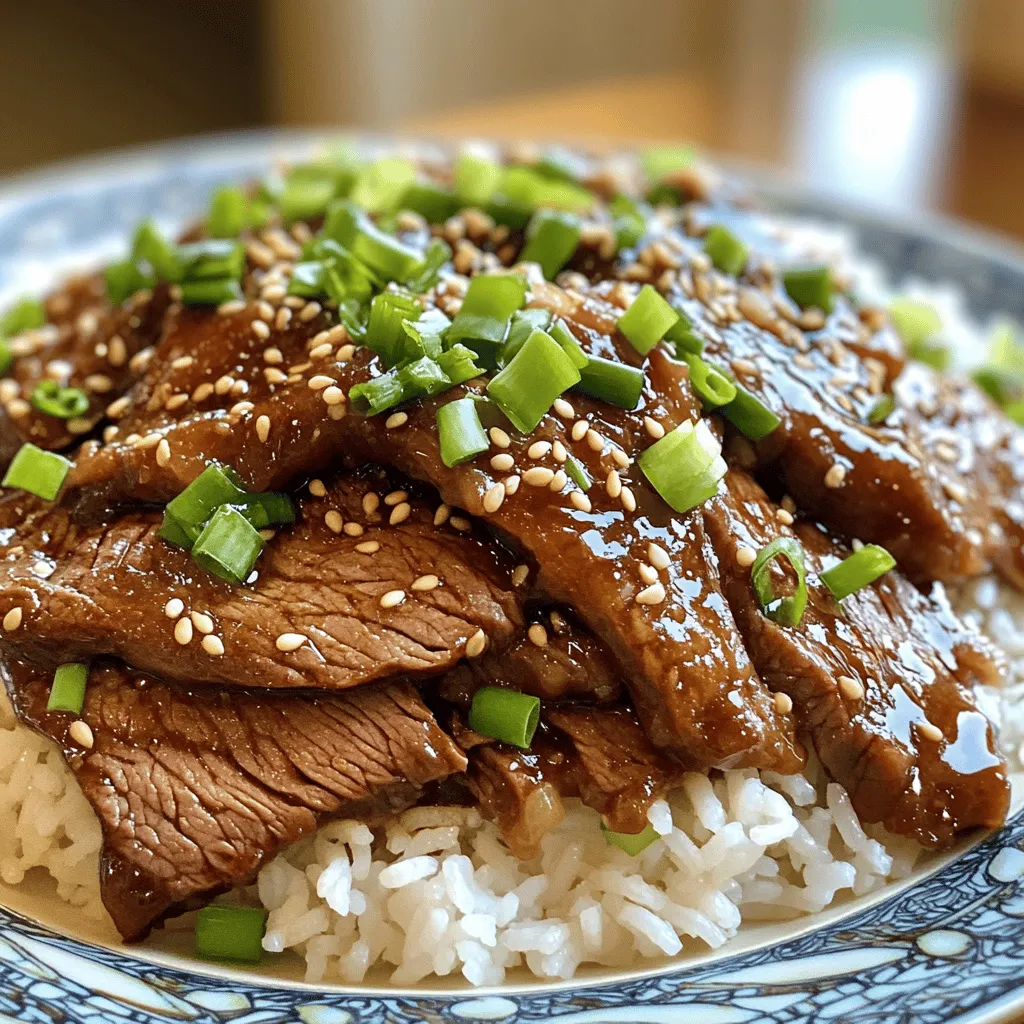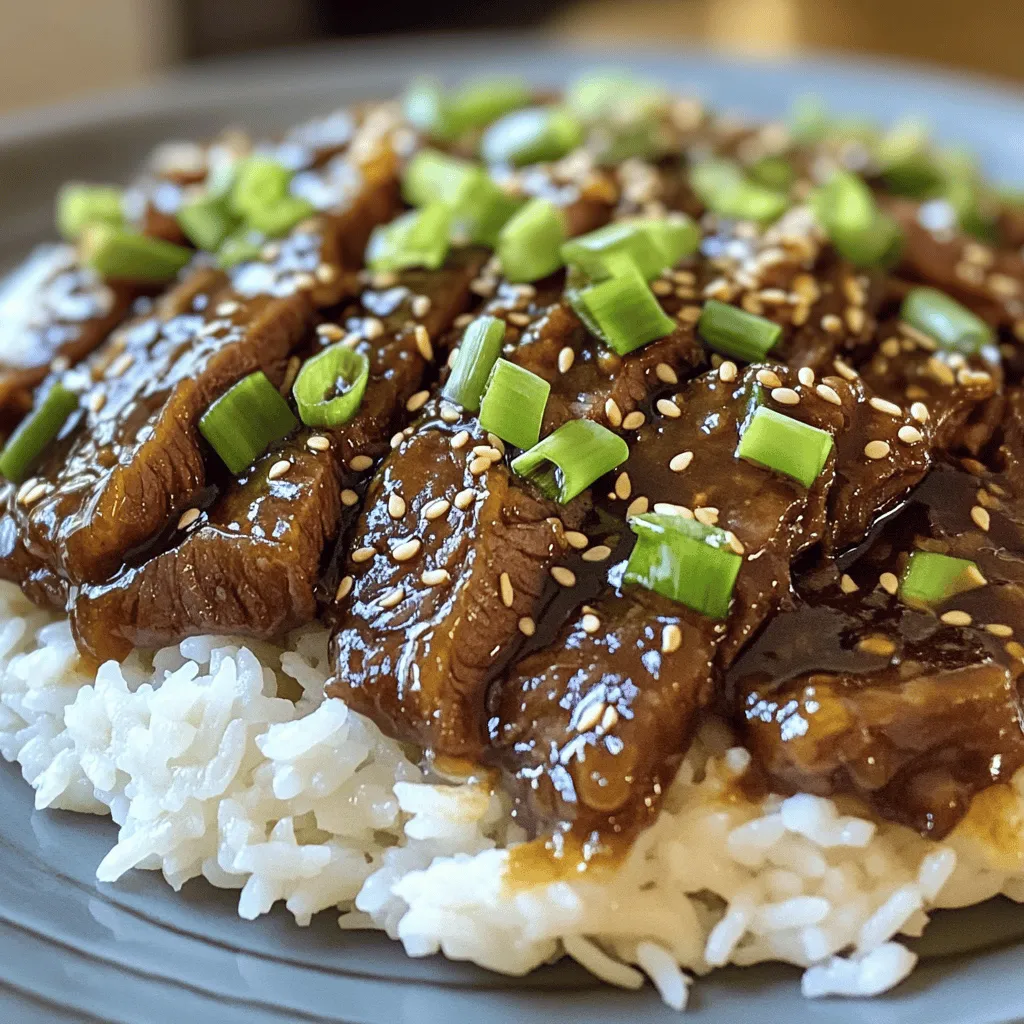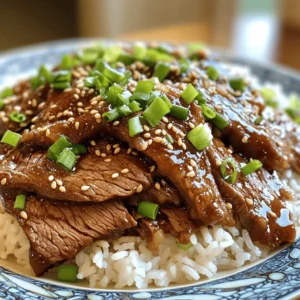Are you ready to cook up a dish that’s better than your favorite takeout? In this article, I’ll show you how to make Mongolian Beef that explodes with flavor. You’ll learn about the simple ingredients you need, easy cooking steps, and expert tips to get that perfect taste. Trust me, once you try this recipe, you’ll never want to order out again!

Ingredients
Main Ingredients
– 1 lb flank steak, thinly sliced against the grain
– 1/4 cup cornstarch
– 2 tablespoons vegetable oil
– 1 tablespoon sesame oil
Aromatics and Seasonings
– 4 green onions, chopped (white and green parts separated)
– 3 cloves garlic, minced
– 1 teaspoon fresh ginger, grated
Sauce Components
– 1/4 cup soy sauce
– 1/4 cup brown sugar
– 1/2 teaspoon red pepper flakes (optional for heat)
Gathering the right ingredients is key to making Mongolian beef that beats takeout. Flank steak is my go-to choice. It has the right amount of tenderness and flavor. Slicing it against the grain makes it even more tender. The cornstarch helps create a nice crust when you sear the beef.
Next, the oils. I use vegetable oil for frying and sesame oil for that nutty flavor. The combination adds depth to each bite. The aromatics are also super important. Green onions, garlic, and ginger bring freshness and warmth.
Now, let’s talk sauce. Soy sauce gives a salty kick, while brown sugar adds sweetness. Don’t forget the red pepper flakes if you want some heat. This balance of flavors is what makes your Mongolian beef truly pop!
Step-by-Step Instructions
Preparing the Beef
– Coating with cornstarch: Start by taking your thinly sliced flank steak. Place it in a medium bowl and add 1/4 cup of cornstarch. Toss the beef well until each piece is coated. This step helps create a crispy texture.
– Rest time for adhesion: Let the beef sit for about 15 minutes. This resting time allows the cornstarch to stick to the meat.
Cooking the Beef
– Heating the oils: Grab a large skillet or wok. Heat 2 tablespoons of vegetable oil and 1 tablespoon of sesame oil over medium-high heat. Wait until the oil shimmers. This means it’s hot enough to sear the beef.
– Searing the beef: Add the coated beef to the skillet in a single layer. Don’t overcrowd the pan. Cook each side for about 2-3 minutes until browned. Once done, take the beef out and set it aside.
Creating the Flavor Base
– Sautéing aromatics: In the same skillet, toss in the white parts of the chopped green onions, 3 minced garlic cloves, and 1 teaspoon of grated ginger. Stir-fry these for about 1 minute until they smell amazing.
– Preparing the sauce: In a small bowl, mix together 1/4 cup of soy sauce, 1/4 cup of brown sugar, and 1/2 teaspoon of red pepper flakes if you like some heat. Pour this sauce mix into the skillet with the aromatics. Stir well to combine.
Final Assembly
– Combining beef with the sauce: Bring the sauce to a boil, then lower the heat. Add the cooked beef back into the skillet. Stir to coat the beef well with the sauce.
– Thicken the sauce: Cook for an additional 2 minutes. This lets the sauce thicken slightly, making it rich and flavorful. Stir in the green parts of the green onions just before serving.
Tips & Tricks
Achieving the Best Flavor
Marinating beef is key. It helps the meat soak up flavors. I suggest a quick marinate with soy sauce and brown sugar. Even a short time boosts taste. Fresh ingredients matter too. Use crisp green onions, garlic, and ginger. They add brightness and depth to the dish.
Cooking Techniques
Heat your skillet well. A hot skillet gives that nice sear. I recommend medium-high heat. This locks in juices and flavor. Avoid overcrowding your pan. Cook in batches if needed. This way, each piece gets good color and cooks evenly.
Presentation Ideas
Garnish with sesame seeds for a nice crunch. It adds a lovely touch. You can serve it over rice or noodles. This makes for a filling meal. Place the beef in the center and sprinkle green onions on top. This looks great and tastes even better!

Variations
Adding Vegetables
You can make your Mongolian beef even better by adding veggies.
– Incorporating bell peppers: Slice some bell peppers into strips. Add them when you sauté the aromatics. They bring color and crunch.
– Using broccoli or snap peas: Broccoli florets or snap peas add a nice bite. Toss them in just before you add the sauce. This keeps them bright and fresh.
Adjusting the Spice Level
Want more heat? You can easily adjust the spice in your dish.
– Adding more red pepper flakes: If you like it spicy, add more red pepper flakes. Start with an extra half teaspoon. Taste as you go.
– Including chili paste: A tablespoon of chili paste gives a deeper heat. Mix it into the sauce for a bold flavor kick.
Alternative Protein Options
You can switch up the protein for a new twist.
– Using chicken or tofu: Chicken breast or thighs work great. Tofu is perfect for a vegetarian option. Just cook them the same way as the beef.
– Beef cuts for different textures: Try sirloin or ribeye for a different texture. Each cut offers a unique taste and feel.
Storage Info
Refrigeration Guidelines
To store your leftover Mongolian beef, let it cool first. Place it in an airtight container. This keeps the beef fresh and safe to eat. I recommend using glass or plastic containers. They help maintain the flavor and texture well.
Freezing Instructions
You can freeze Mongolian beef for later meals. First, let it cool completely. Then, place it in a freezer-safe bag or container. Make sure to remove as much air as possible. This helps prevent freezer burn. When you are ready to eat, thaw it in the fridge overnight. Reheat it in a skillet over medium heat. This keeps the beef juicy.
Shelf Life
In the fridge, Mongolian beef lasts about 3 to 4 days. Always check for any signs of spoilage before eating. When frozen, it can last up to 3 months. Just make sure to label your container or bag with the date. This way, you know how long it has been stored.
FAQs
Can I make Mongolian beef ahead of time?
Yes, you can prepare Mongolian beef in advance. Here are some tips for pre-cooking:
– Cook the beef: Follow the recipe until step six.
– Cool and store: Let the beef cool, then place it in an airtight container.
– Refrigerate: Store the beef in the fridge for up to three days.
– Reheat gently: Use low heat on the stove or microwave to warm it up.
What can I serve with Mongolian beef?
Mongolian beef pairs well with many sides. Here are some ideas:
– Steamed rice: White or brown rice works well.
– Noodles: Try egg noodles or rice noodles for a tasty option.
– Vegetables: Serve with steamed broccoli or sautéed snap peas for color.
– Salad: A light cucumber salad adds a refreshing touch.
Is Mongolian beef spicy?
Mongolian beef is not very spicy. However, you can adjust the heat:
– Red pepper flakes: Add more if you like it hot.
– Chili paste: Mix in chili paste for a bolder kick.
– Omit spice: Skip the red pepper flakes for a milder dish.
Mongolian beef is easy to make and full of flavor. We covered key ingredients, like flank steak and fresh aromatics. I shared tips to enhance taste and cooking methods to get that perfect sear. You can even customize this dish with veggies or different proteins.
With proper storage, your leftovers will stay fresh. Cooking this meal brings joy and warmth to your table. Enjoy creating this dish and tweaking it to your taste!

